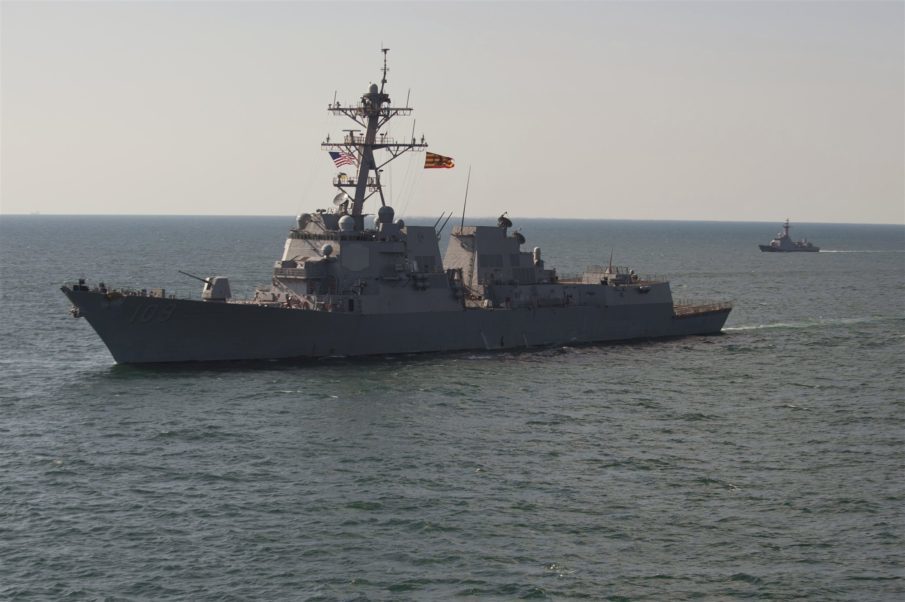Our decision to have two ships simultaneously operate in the Black Sea is proactive, not reactive," US Navy Vice Adm. Christopher Grady, the commander of 6th Fleet, said in a press release.Saturday's arrival of the Carney marks the first time two American warships have been in the Black Sea at the same time since Ukraine hosted a training operation in July of last year, but they won't be alone for long. One day after the Carney's arrival, the Kremlin announced new naval deployments to the waterway as well, with a Russian frigate, the Admiral Essen, and two patrol ships entering the Black Sea soon thereafter.
"We operate at the tempo and timing of our choosing in this strategically important region. By nature, ships are flexible, mobile forces, and the Navy is uniquely capable of providing credible and capable forces to defend our nation's interests throughout the world."
Tensions between the NATO alliance and Russia have been on a steady climb since the Russian military annexation of Crimea in 2014. Since then, NATO has been bolstering its defenses in the region, and if their reports of Russian activity in the vicinity are accurate, so has Russia. Because the Kremlin remains tight lipped about the allocation of their defensive assets, there has been no formal confirmation of Russia's military build up in Crimea and surrounding territory, but the uptick in both safe and unsafe intercepts between Russian and NATO aircraft in recent years seem to support NATO's claims.
Last year, during massive military exercises Russian conducted in the region along with ally Belarus, many NATO officials voiced concerns about the Russian military leaving staged heavy equipment in the Russian satellite of Kaliningrad, which abuts a notable choke point between NATO allies in the Baltics and the rest of Europe.
Just last month, a Russian Su-27 conducted an unsafe intercept of an unarmed EP-3 Aries surveillance aircraft, passing within just five feet of the U.S. Navy plane at one point during the nearly three hour encounter. These sorts of intercepts, while not uncommon between Russian and NATO aircraft in a number of places around the globe, have been happening with increased frequency since 2014.
The Kremlin, however, has repeatedly claimed that there has been no build up of military assets in the region, particularly in Crimea where NATO reports indicate not only an amassing of forces, but also the addition of a number of anti-aircraft assets and even submarines.
Recently, the United States has been making a number of accusations against Russia - both regarding the strengthening of Russia's nuclear capabilities and the increase in the number of nuclear weapons, now regarding the increase in its [military] presence in the Black Sea." Yevgeny Serebrennikov, the first deputy chair of the Russian upper house's defense committee told the Kremlin owned news outlet Sputnik on Tuesday.According to the 6th Fleet, the two Arleigh Burke-class guided-missile destroyers in the Black Sea are there simply to "conduct maritime security operations," but at least one U.S. official has characterized the operation as part of a desensitization effort, aimed at forcing Russia to grow accustomed to an American military presence in the region. Whether intentionally or not, that official's statements seem to suggest that NATO and Russia have entered into the early stages of a new Cold War.
"These are all direct lies, attempts to divert attention away from the US' own build-up of armaments and military presence. Such attempts, as the Russian president and the defense minister, have repeatedly said, will not succeed."
In the Cold War we had a dance we did and everybody knew their roles in the dance: You fly your bomber here, I'll fly my bomber there. You put a ship here, I'll put a ship there," an official who requested his name be omitted said.
"I don't think we've got to that level yet, and so we're still trying to figure out what that dance looks like in the year 2018 versus what it was back in the Cold War, and I think there are some growing pains, obviously."




Comment: The early stages of a new Cold War? It seems that the Cold War has been going for a while already and is only getting worse. At least the U.S. anti-Russia hysteria suggests so:
The new Idiocracy consensus is that Russia committed an "act of war" on par with Pearl Harbor and 9/11 - should the US respond accordingly?